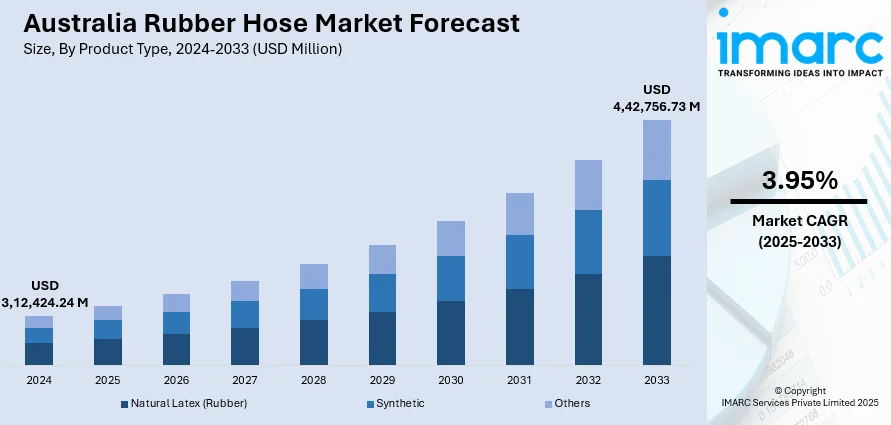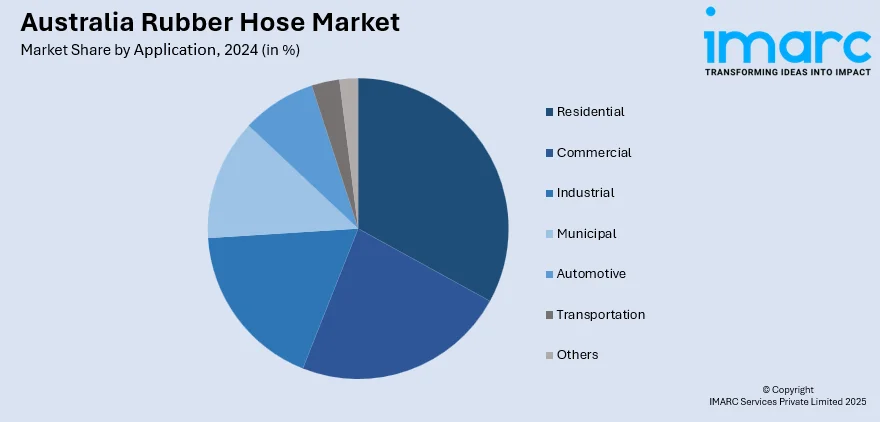
Australia Rubber Hose Market Size, Share, Trends and Forecast by Product Type, Media, Pressure Rating, Application, and Region, 2025-2033
Australia Rubber Hose Market Overview:
The Australia rubber hose market size reached USD 3,12,424.24 Million in 2024. Looking forward, IMARC Group expects the market to reach USD 4,42,756.73 Million by 2033, exhibiting a growth rate (CAGR) of 3.95% during 2025-2033. The growing industrialization, demand from the mining and agricultural sectors, infrastructure development, and the need for long-lasting, high-performance fluid transfer solutions is aiding the Australia rubber hose market share. Environmental laws and a shift toward sustainable materials also lead to innovation, whereas digitalization facilitates predictive maintenance and operational efficiency across industries.
|
Report Attribute
|
Key Statistics
|
|---|---|
|
Base Year
|
2024 |
|
Forecast Years
|
2025-2033
|
|
Historical Years
|
2019-2024
|
| Market Size in 2024 | USD 3,12,424.24 Million |
| Market Forecast in 2033 | USD 4,42,756.73 Million |
| Market Growth Rate 2025-2033 | 3.95% |
Australia Rubber Hose Market Trends:
Shift Toward Sustainable and Eco-Friendly Materials
The increasingly embracing sustainability is a major Australia rubber hose market trend. Manufacturers are prioritizing the use of environmentally friendly materials, such as bio-based rubber or recycled compounds, in response to rising environmental awareness and regulatory pressure. This shift isn't just about reducing carbon footprints it also caters to customer demand for greener products. Companies are investing in research and development (R&D) to maintain durability and flexibility while minimizing environmental impact. Additionally, there's a growing focus on sustainable production practices, including energy-efficient manufacturing and waste reduction. This trend is likely to deepen as both consumers and industrial buyers continue to favor products that align with broader sustainability goals across agriculture, mining, and construction sectors.

To get more information on this market, Request Sample
Growth of Specialized and High-Performance Hoses
Rubber hoses designed for high-performance or specialty use are highly demanded in Australia rubber hose market forecast. Industries such as mining, oil and gas, and agriculture require high-temperature hoses, abrasion-resistant hoses, and hoses capable of withstanding corrosive chemicals. Companies are producing hoses with reinforcing layers, advanced polymers, and innovative coatings that enhance lifespan and safety in a bid to meet these needs. Modification of hose design, including tailor-made fittings, pressure ratings, and lengths, is also being driven by this trend. High-end, performance-oriented solutions that ensure reliability and reduce downtime are being provided by the industry to meet the increased complexity of industrial applications and safety regulations tightening up.
Digitalization and Smart Hose Integration
Digital innovation gradually is transforming the Australia rubber hose market outlook. Intelligent hoses with sensor-based temperature, pressure, wear, or real-time flow rates are increasingly demanded, even if the technology still is in infancy stages. In diminishing the possibility of downtime, along with promoting safety, the technologies enable determining issues before these are critical in nature. In industries where equipment reliability is essential, such as manufacturing and mining, the deployment of such smart systems is of special significance. Additionally, digital inventory management and predictive maintenance platforms are becoming widely adopted, enabling businesses to track hose usage, plan replacements on schedule, and improve performance. As the Industrial Internet of Things (IIoT) continues to gain ground, digitalized hose systems will become an increasingly larger market segment further strengthening the Australia rubber hose market growth.
Australia Rubber Hose Market Segmentation:
IMARC Group provides an analysis of the key trends in each segment of the market, along with forecasts at the country and regional levels for 2025-2033. Our report has categorized the market based on product type, media, pressure rating, and application.
Product Type Insights:
- Natural Latex (Rubber)
- Synthetic
- Others
A detailed breakup and analysis of the market based on the product type have also been provided in the report. This includes natural latex (rubber), synthetic, and others.
Media Insights:
- Water
- Oil
- Hot Water and Steam
- Air/Gas
- Food and Beverage
- Chemical
The report has provided a detailed breakup and analysis of the market based on the media. This includes water, oil, hot water and steam, air/gas, food and beverage, and chemical.
Pressure Rating Insights:
- Low
- Medium
- High
A detailed breakup and analysis of the market based on the pressure rating have also been provided in the report. This includes low, medium, and high.
Application Insights:

- Residential
- Commercial
- Industrial
- Municipal
- Automotive
- Transportation
- Others
The report has provided a detailed breakup and analysis of the market based on the application. This includes residential, commercial, industrial, municipal, automotive, transportation, and others.
Regional Insights:
- Australia Capital Territory & New South Wales
- Victoria & Tasmania
- Queensland
- Northern Territory & Southern Australia
- Western Australia
The report has also provided a comprehensive analysis of all the major regional markets, which include Australia Capital Territory & New South Wales, Victoria & Tasmania, Queensland, Northern Territory & Southern Australia, and Western Australia.
Competitive Landscape:
The market research report has also provided a comprehensive analysis of the competitive landscape. Competitive analysis such as market structure, key player positioning, top winning strategies, competitive dashboard, and company evaluation quadrant has been covered in the report. Also, detailed profiles of all major companies have been provided.
Australia Rubber Hose Market News:
- In July 2024, Pacific Hoseflex, a leading Australian engineering company, continues to support the onshore oil and gas industry with high-quality, specialised products. Known for its expertise in lined piping systems, the company emphasizes precision, durability, and custom solutions. With a strong focus on performance and safety, Pacific Hoseflex remains a trusted partner in delivering engineered piping products tailored to the demanding needs of energy sector operations.
Australia Rubber Hose Market Report Coverage:
| Report Features | Details |
|---|---|
| Base Year of the Analysis | 2024 |
| Historical Period | 2019-2024 |
| Forecast Period | 2025-2033 |
| Units | Million USD |
| Scope of the Report |
Exploration of Historical Trends and Market Outlook, Industry Catalysts and Challenges, Segment-Wise Historical and Future Market Assessment:
|
| Product Types Covered | Natural Latex (Rubber), Synthetic, Others |
| Medias Covered | Water, Oil, Hot Water and Steam, Air/Gas, Food and Beverage, Chemical |
| Pressure Ratings Covered | Low, Medium, High |
| Applications Covered | Residential, Commercial, Industrial, Municipal, Automotive, Transportation, Others |
| Regions Covered | Australia Capital Territory & New South Wales, Victoria & Tasmania, Queensland, Northern Territory & Southern Australia, Western Australia |
| Customization Scope | 10% Free Customization |
| Post-Sale Analyst Support | 10-12 Weeks |
| Delivery Format | PDF and Excel through Email (We can also provide the editable version of the report in PPT/Word format on special request) |
Key Questions Answered in This Report:
- How has the Australia rubber hose market performed so far and how will it perform in the coming years?
- What is the breakup of the Australia rubber hose market on the basis of product type?
- What is the breakup of the Australia rubber hose market on the basis of media?
- What is the breakup of the Australia rubber hose market on the basis of pressure rating?
- What is the breakup of the Australia rubber hose market on the basis of application?
- What is the breakup of the Australia rubber hose market on the basis of region?
- What are the various stages in the value chain of the Australia rubber hose market?
- What are the key driving factors and challenges in the Australia rubber hose market?
- What is the structure of the Australia rubber hose market and who are the key players?
- What is the degree of competition in the Australia rubber hose market?
Key Benefits for Stakeholders:
- IMARC’s industry report offers a comprehensive quantitative analysis of various market segments, historical and current market trends, market forecasts, and dynamics of the Australia rubber hose market from 2019-2033.
- The research report provides the latest information on the market drivers, challenges, and opportunities in the Australia rubber hose market.
- Porter's five forces analysis assist stakeholders in assessing the impact of new entrants, competitive rivalry, supplier power, buyer power, and the threat of substitution. It helps stakeholders to analyze the level of competition within the Australia rubber hose industry and its attractiveness.
- Competitive landscape allows stakeholders to understand their competitive environment and provides an insight into the current positions of key players in the market.
Need more help?
- Speak to our experienced analysts for insights on the current market scenarios.
- Include additional segments and countries to customize the report as per your requirement.
- Gain an unparalleled competitive advantage in your domain by understanding how to utilize the report and positively impacting your operations and revenue.
- For further assistance, please connect with our analysts.
 Request Customization
Request Customization
 Speak to an Analyst
Speak to an Analyst
 Request Brochure
Request Brochure
 Inquire Before Buying
Inquire Before Buying




.webp)




.webp)












